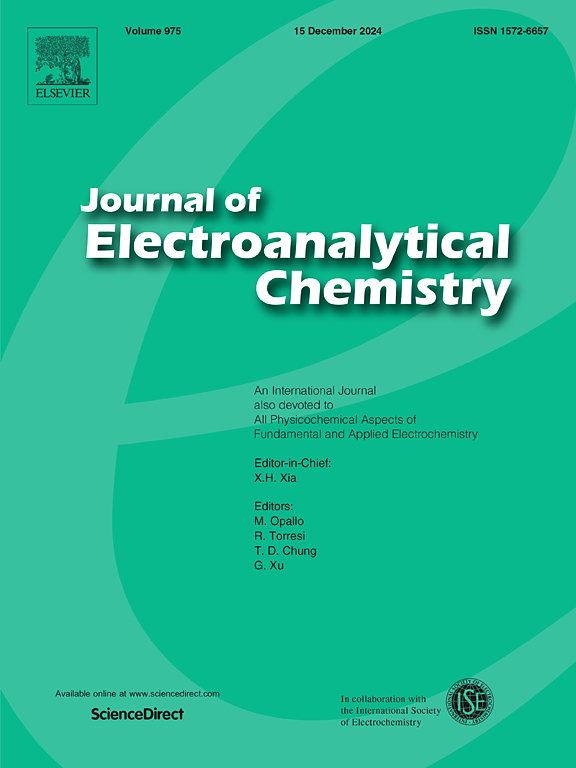Aqueous electrocatalytic properties of nitrogen-doped carbon electrodes synthetized by innovative electrochemical process in molten NaCl-KCl
IF 4.1
3区 化学
Q1 CHEMISTRY, ANALYTICAL
引用次数: 0
Abstract
This work presents the development of CNX electrodes by simple electrooxidation of nitride ions (N3−) into nitrogen on carbon surface in molten eutectic NaCl-KCl at 750 °C with Li3N (2 mol kg1) as nitrogen precursor. The influence of electrolysis parameters such as the N-amount doped, the electrodeposition rate and the thermic post-treatment applied was studied and electrocatalytic properties obtained were compared in aqueous solutions with Fe(II)/Fe(III) redox system at room temperature. It appears that increasing the amount of nitrogen deposited induced an increase of electrocatalytic properties with the record of highest current peak densities and the highest capacitive currents. Furthermore, decreasing the electrodeposition rate or apply a thermic post-treatment consisting of leaving the CNX electrode at 750 °C during 1 h, leaded to a decrease of capacitive current and an increase of electron transfer rate.

创新电化学工艺合成的氮掺杂碳电极在NaCl-KCl熔液中的水电催化性能
本文介绍了在熔融NaCl-KCl共晶溶液中,以Li3N (2 mol kg1)为氮前驱体,在750℃下将氮离子(N3−)在碳表面简单电氧化成氮,从而制备CNX电极的方法。研究了n掺杂量、电沉积速率和热后处理等电解参数对电催化性能的影响,并比较了室温下Fe(II)/Fe(III)氧化还原体系水溶液中的电催化性能。结果表明,氮沉积量的增加导致了电催化性能的提高,并记录了最高的电流峰值密度和最高的电容电流。此外,降低电沉积速率或应用热后处理,包括将CNX电极在750℃下放置1小时,导致电容电流降低和电子传递速率增加。
本文章由计算机程序翻译,如有差异,请以英文原文为准。
求助全文
约1分钟内获得全文
求助全文
来源期刊
CiteScore
7.80
自引率
6.70%
发文量
912
审稿时长
2.4 months
期刊介绍:
The Journal of Electroanalytical Chemistry is the foremost international journal devoted to the interdisciplinary subject of electrochemistry in all its aspects, theoretical as well as applied.
Electrochemistry is a wide ranging area that is in a state of continuous evolution. Rather than compiling a long list of topics covered by the Journal, the editors would like to draw particular attention to the key issues of novelty, topicality and quality. Papers should present new and interesting electrochemical science in a way that is accessible to the reader. The presentation and discussion should be at a level that is consistent with the international status of the Journal. Reports describing the application of well-established techniques to problems that are essentially technical will not be accepted. Similarly, papers that report observations but fail to provide adequate interpretation will be rejected by the Editors. Papers dealing with technical electrochemistry should be submitted to other specialist journals unless the authors can show that their work provides substantially new insights into electrochemical processes.

 求助内容:
求助内容: 应助结果提醒方式:
应助结果提醒方式:


